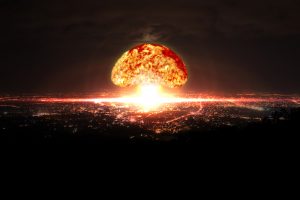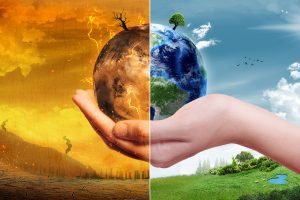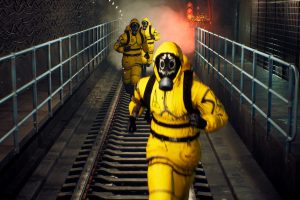
©Makhzan-e-Tasaweer
Sabahat Ali, Mexico
While it was not a nuclear blast, Tuesday’s Beirut explosions served as an unapologetic reminder to the world of the devastating carnage that weapons of mass destruction can entail. People quickly took to Twitter, calling the blast reminiscent of a small nuclear explosion. A smoking building warped into a devouring monster of relentless energy and flames within a second. The blast radius was recorded from numerous angles: smartphones, dashcams, security footage. Even a bridal shoot happening at the time recorded the unceasing torque of the explosion. Everything in its way was either hurled back or decimated.
First-hand eyewitnesses remark that it was the deadliest explosion they have ever seen. A New York Times reporter present in Beirut at the time of the blast, Vivian Yee, put it into perspective: ‘When the world stopped cracking open, I couldn’t see at first because of the blood running down my face.’ [1]

This harrowing eruption serves as a telling reminder of another horror millions of times more destructive which took place 75 years ago today. On August 6th 1945, the Japanese towns of Hiroshima, then Nagasaki three days later, were devastated by what can only be described as a doomsday of sorts. For the hibakusha [survivors of the Hiroshima/Nagasaki bombings], the blast that transformed their world into, literally, a post-apocalyptic landscape cannot be conveyed in words.

The various accounts of that fateful day are brushstrokes of a menacing mural: a five-year-old playing under a persimmon tree who saw the entire sky go white and then instantly black. A university student who went from breathing fresh air to enduring the putrid stench of vaporised and burning flesh against the backdrop of shrill screaming. A 16-year-old conscripted worker in a government office who recalls that all the air was as though vacuumed from the room. During his subsequent escape through the mountains, he recounts a dying woman clinging to his legs begging for water. When he attempted to help her up, her skin came off in his hands [2].
A Trigger-Happy Tussle
There are two groups of people who advocate against the production and proliferation of nuclear weaponry. The first, of course, comprises those who have lived to tell the tale.
Takato Michishita is one such survivor. In a letter addressed to the world, he implores:
‘Dear young people who have never experienced war – wars begin covertly. If you sense it coming, it may be too late. Japan is the only nation that has experienced a nuclear attack. We must assert, with far more urgency, that nuclear weapons cannot coexist with mankind. The current administration is slowly leading our nation to war, I’m afraid. At the ripe age of 78, I have taken it upon myself to speak out against nuclear proliferation. Now is not the time to stand idly by.’ [3]

©Shutterstock
But the average age of this first group of advocates for nuclear disarmament is now over 85 years old.
The second group of people comprises those making the untellable agony of this dwindling demographic their own – a group determined not to let the invaluable voices and critical message of the hibakusha go in vain. In a world which, until recently, considered Islamist militant terrorism to be one of the greatest threats to the west, there stands an advocate against the ghastly terrors of mutually assured destruction who has been brazenly calling all major world leaders to demilitarise their nuclear arsenal. Hazrat Mirza Masroor Ahmad (aba), the Fifth Caliph and Worldwide Head of the Ahmadiyya Muslim Community has written dozens of letters to world leaders and delivered a multitude of addresses with particular focus on global peace.
One of the hallmark points to which he has drawn the attention of policy-makers globally is the need for nuclear disarmament. Addressing various academic leaders and political dignitaries at a Peace Conference in Tokyo, Japan, His Holiness (aba) remarked:
“At the time of the Second World War, the United States possessed nuclear weapons that, although extremely destructive, were nowhere near as powerful as modern-day nuclear weapons. Furthermore, now it is not just the major powers that have nuclear bombs, but even a number of smaller countries possess them [4].”
Less than two decades after the Hiroshima and Nagasaki bombings, the Soviet Union had already developed (and tested) bombs which possessed such a monstrous blast-radius that, if dropped in Central London, would utterly annihilate everything until (and including) Gatwick airport. And this would only be the immediate effect. By 1961, deleting an entire city from the plane of existence was as easy as pressing backspace on a keyboard. Today, the collective nuclear capability of the world is literally millions of times that.
Despite the unspeakable consequences that such bombs carry, pro-nuclear advocates argue that the sheer scale of destruction is exactly what will prevent it from happening in the first place. This argument is like putting up a sharp-edged sign that reads ‘This sign has sharp edges.’ Why risk putting up the sign at all?

©Shutterstock
In riposte to this phenomenally feeble justification, His Holiness (aba) explains:
“Whilst perhaps the major powers keep such weapons as a deterrent, there is no guarantee that the smaller countries will show such restraint. We cannot take it for granted that they will never use nuclear weapons. Thus, it is clear that the world stands on the brink of disaster [5].”
In today’s hyper-digitised world, hackers, computer malfunctions and false alarms are very real triggers, let alone the ceaselessly expanding margin of human error (and ineptitude) which seems to characterise some leaders who possess them. A former US defence secretary recently observed in an interview that nuclear war is “as likely as ever” [6].
During the Peace Symposium in 2015, His Holiness (aba) shed a revealing light on just how imminent such a threat could be. He remarked:
“What causes great fear is the knowledge that such nuclear weapons could end up in the hands of people who either do not have the ability or who choose not to think about the consequences of their actions. In truth, such people do not even care about the consequences and are trigger-happy.”
These words have gained a stomach-turning potency against the socio-political landscape of 2020. Just last year, Professor Tyler Cowan of George Mason University told Bloomberg Magazine:
‘One of the most striking facts of today’s world is that young people do not seem to worry very much about nuclear war. Climate change is by far the larger concern, while nuclear war is seen as a threat of the past… In contrast, I am inclined to think that the risk of nuclear war remains the world’s number-one problem, even if that risk does not seem so pressing on any particular day.’
This year, researchers have started publishing more on the global effects that a ‘small’ or localised nuclear war between relatively smaller nations would have. The results are mortifying. It turns out that the modelled figures project anything from 1 billion people without food to a full-fledged nuclear winter [7]. Keeping in mind that a ‘localised’ nuclear war between two smaller nations is many times more likely than an all-out war, this is yet another reality check.
Add to this the fact that several nations are opting out of arms-control efforts, leaving their trigger-happy fingers to the caprice of their own unpredictable fancies. As though this was not already a recipe for Armageddon, the dangers of brinkmanship make for an even greater probability of nuclear war. Brinkmanship is a reckless strategy used by nations possessing nuclear artillery to deliberately allow the escalation of tensions, to put pressure on another nation with the unspoken threat of nuclear engagement.
A Final Dimension of Catastrophe
On March 25, 2012, Hazrat Mirza Masroor Ahmad (aba) spoke of the haunting cross-generational curse that a nuclear cloud would engrave upon the fate of humankind. He said:
“The weapons available today are so destructive that they could lead to generation after generation of children being born with severe genetic or physical defects. Drinking water, food and vegetation will all be contaminated by radiation. We can only imagine what type of diseases such contamination will lead to.”
Just last year, at the UK Peace Symposium, His Holiness (aba) again observed: “If there is a nuclear war, we will not only be destroying the world today, but will also be leaving behind a lasting trail of destruction and misery for our future generations.”
According to the UCLA’s Children of the Atomic Bomb Project: ‘The incidence of miscarriage, stillbirth and death during infancy [of those affected by post-explosive radiation] was 43 percent, seven times the incidence in a control group who were considered to have received no radiation.’ [8]
It is one thing to inflict immeasurable destruction upon the present; it is totally another to pass cruel and twisted judgement upon the unborn children of the morrow. Nuclear weapons do not suffice at ruthlessly obliterating everything in their sight.
No – the nefarious effects of such weapons linger in the waters; they remain sinisterly suspended in the atmosphere. They render soils barren and contaminated while subjecting whatever vegetation that remains to inhuman radiation levels. It is akin to sending a bomb into the unassuming future, crippling us today and cursing us tomorrow.
To permit the proliferation and production of nuclear arsenal is to decorate the memory of the hibakusha survivors with monuments of cross-generational destruction. As Henri Barbusse, the famous French writer, wrote over a century ago: ‘Two armies that fight each other is like one large army that commits suicide.’
About the Author: Sabahat Ali is a graduate from the Canadian Ahmadiyya Institute of Languages and Theology. He currently serves as an Imam of the Ahmadiyya Muslim Community in Mexico, and is a regular contributor for the Review of Religions.
ENDNOTES
[1] New York Times, Vivian Yee, I Was Bloodied and Dazed. Beirut Strangers Treated Me Like a Friend. Aug. 4, 2020.
[2] New York Times, Survivors Recount Horrors of Hiroshima and Nagasaki. May 28, 2016
[3] Time Magazine, After the Bomb, Paul Moakley/Lily Rothman
[4] The Keys to Peace in a Time of Global Disorder, Hazrat Mirza Masroor Ahmad (aa), Nov. 2015
[5] Ibid.
[6] To the Point, KCRW Podcast, Nuclear war is as likely as ever, says former defence secretary William Perry, July 16, 2020
[7] Nature, Alexandra Witze, How a small nuclear war would transform the entire planet, March 16, 2020
[8] Children of the Atomic Bomb, UCLA Children’s Eyewitness Report, https://www.aasc.ucla.edu/cab/200708230012.html




Add Comment